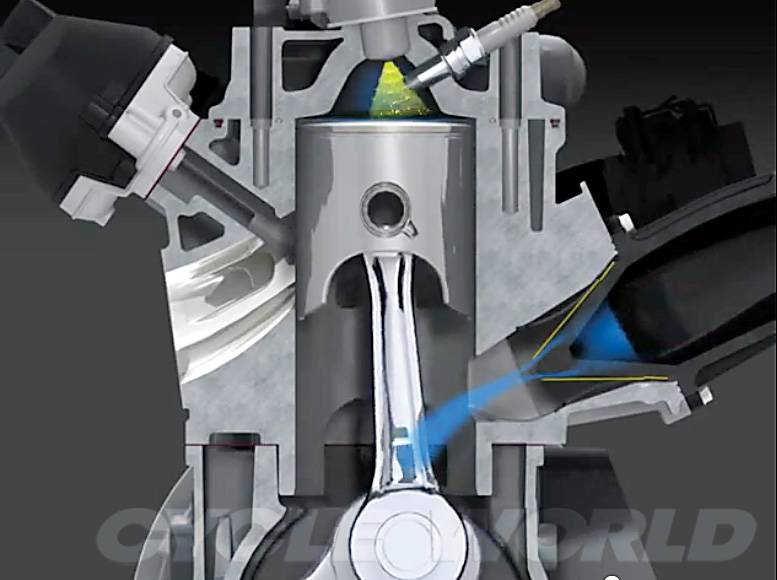Direct Injected and Street Legal? Bring it on!
Husqvarna 300 DI Concept – Illustration by C.G. Design
Husqvarna executives say their engineers are developing a street-legal, direct-injected, two-stroke-powered dual-sport. This illustration represents what we think the bike might look like.
During our recent visit to Husqvarna, company executives said they have a high-tech two-stroke, likely directly injected, in their near-term product plan. At KTM, a tech-services manager claims that the company has a direct-injection two-stroke under test, essentially ready to go when there’s a need in the marketplace. Other companies drop hints that they’re reevaluating their prior decisions to go 100-percent four-stroke with their dirtbike lines. Are two-stroke engines on the verge of a revival?
The answer to that question is yes, at least to a limited extent.
Two-stroke engines in motorcycle applications went away for several reasons. First, they had higher levels of hydrocarbon and carbon-monoxide exhaust emissions than four-stroke engines, and reducing those emissions couldn’t readily piggyback on all the work that had been expended by the automotive industry on car engines. Second, they also had worse fuel economy. But, third, and worst of all, they were perceived as “non-green,” smoke-emitting, image disasters. Major companies such as Honda made the decision to stop producing two-strokes, and racing organizations went along by changing rules to penalize or eliminate them. Four-strokes, with a few exceptions, took over off-road motorcycling, even in closed-course competition.
But there was a cost to that. The new four-stroke motocrossers were more expensive and much more maintenance-intensive than the two-stroke machines they replaced. They also tended to have exhaust sound that was offensive for longer distances, putting pressure on motocross tracks in some locations to quiet down or be shut down. And some riders simply liked two-stroke engine characteristics better.
But two other off-road activities also faced the same issues and came up with different solutions. Both the outboard-marine industry and the snowmobile industry initially attempted to make the switch to four-stroke engines but were met with customer resistance to the heavier and more-expensive powerplants that resulted. This opposition led to a new generation of cleaner, direct-injected two-stroke engines that meet respective emissions requirements—though these are notably less strict than those for on-road vehicles. The most recent example would be Ski-Doo’s E-TEC (ecotech) 800cc Rotax Twin, which puts out 155 horsepower—more power per cc than BMW’s S1000RR, the current king of literbike horsepower. Unlike Bimota’s abortive 1997 Vdue, a two-stroke with conventional injectors squirting into the transfer ports—a design that never really worked—the outboard and snowmobile engines are well-developed and reliable.
This cutaway illustrates how fuel is injected very late in the compression cycle when the exhaust port is blocked, dramatically improving efficiency.
Now that such technology is available for motorcycle engines, some players in the industry are taking another look, since direct fuel injection has the potential to drastically reduce emissions. Two-stroke engines, which combine the intake and exhaust cycles to a degree not possible in four-strokes, have an issue with fresh charge coming through their transfer ports and flowing directly out the exhaust port, dramatically raising hydrocarbon emissions—and not helping fuel economy, either. Direct injection allows fuel to be injected into the cylinder just as the piston is rising to seal the exhaust port, preventing this direct short-circuiting.
Similarly, conventional two-stroke engines at very low loads may actually be operating on four-, six- or eight-cycle processes. This is because so much exhaust gas is retained in the cylinder at small throttle openings that it may take several crankshaft revolutions to clear the cylinder sufficiently to create a combustible mixture. It’s far better to operate at low loads with intake air only (no fuel lost out the exhaust) and the injection programmed to add fuel only on the combustible cycle. When used with engines designed for them, direct injection systems allow much lower baseline emissions before any after-treatment system (catalytic converter) is added, and they can improve fuel economy by as much as 50 percent.
In addition to direct fuel injection, there are other technologies that can help. Two decades ago, Honda introduced a 250cc, two-stroke motorcycle engine for a Japanese-market-only dual-purpose bike that utilized “Activated Radical Combustion.” This is a technology that has since been well-studied by the automotive industry and is more commonly known as HCCI (Homogenous Charge Compression Ignition), a combustion process that requires no spark but uses gasoline rather than diesel fuel. In Honda’s 250, HCCI combustion was maintained from about eight to 50 percent load, with conventional spark ignition used at both the high and low end of the engine load range. The benefit was far more stable combustion (no six- or eight-cycling) when HCCI was operating, lower emissions and—according to those who rode it—a two-stroke that felt as if it had the smooth power of a four-stroke. Honda’s patents have since expired.
While there is little doubt that technology exists to create off-road two-stroke motorcycle engines that meet current and future EPA or California green-sticker off-road emissions requirements, the question remains whether sufficient technology exists to create street-legal two-stroke engines as in, say, a 300cc dual-purpose bike making 40-plus horsepower. This would require one of the available direct-injection technologies, an oxidizing catalyst in the exhaust and, likely, a direct lubrication system that feeds carefully controlled amounts of oil to the main and rod bearings to minimize oil usage. While that question currently remains unanswered, there is at least one top engine designer at a major manufacturer who believed it was possible five years ago. The technology has only gotten better since.
Story by Steve Anderson at Cycle World



